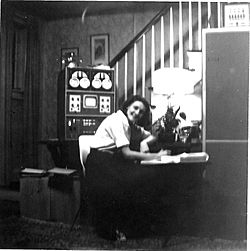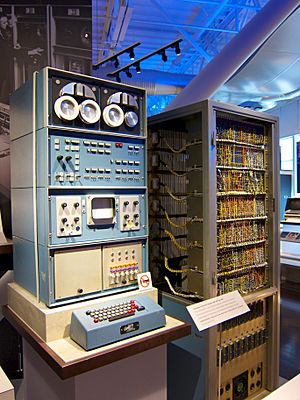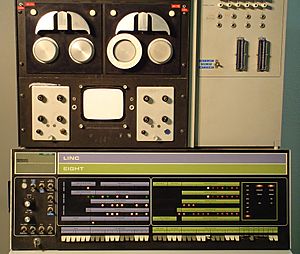LINC facts for kids

LINC home computer with its software designer, Mary Allen Wilkes, 1965
|
|
| Developer | MIT's Lincoln Laboratory |
|---|---|
| Manufacturer | Digital Equipment Corporation and Spear Inc. |
| Type | Minicomputer |
| Release date | March 1962 |
| Introductory price | US$43,600 |
| Units sold | 21 (by DEC) |
| Units shipped | 50 |
| Display | 2 oscilloscope displays |
| Input | Knobs, keyboard |
| Platform | DEC 12-bit |
| Successor | PDP-5, LINC-8, PDP-12 |

The LINC (which stands for Laboratory INstrument Computer) was a special type of computer made in 1962. It used 12-bit words and had 2048 words of memory. Many people think the LINC was the very first minicomputer. It also helped pave the way for the personal computers we use today.
The LINC was designed by Wesley A. Clark and Charles Molnar at MIT's Lincoln Laboratory. Later, companies like Digital Equipment Corporation (DEC) and Spear Inc. built these computers. Back then, a LINC computer cost more than $40,000. This was a lot of money!
The LINC was great for working with science experiments in labs. It could easily connect to other lab tools. It had special inputs and outputs for analog signals, which are like continuous measurements. The design of the LINC was even made public, meaning anyone could use it. A talented software designer named Mary Allen Wilkes created the main program for the LINC, called LAP6.
What Was Inside the LINC Computer?
The LINC had a specific way its parts were organized, which is called its architecture.
Memory and Processing Power
The LINC had 2048 words of memory, but only the first 1024 words could be used for running programs. The other half was just for storing data. It had a special part called an accumulator, which was like a scratchpad for calculations. It also had a "link register" for simple tasks.
The first 16 memory spots had special jobs. For example, location 0 helped the computer remember where to go back to after finishing a small task (a subroutine). The next 15 spots could be used to quickly find information in memory.
How the LINC Handled Numbers
The LINC used a system called "ones' complement" for math. This meant it had a way to show both "plus zero" and "minus zero." This was a bit unusual compared to how most computers work today. Each instruction the LINC followed took about 8 microseconds to complete.
How Users Interacted with the LINC
The LINC had a special keyboard for typing. It could also show text on its screen, which was a bit-mapped CRT (like an old TV screen). You could also connect a teleprinter to get printed copies of your work.
LINC's Special Features
The LINC had some unique parts that made it stand out.
The Control Panel: Taking Control
The LINC's control panel was very useful. It let users go through their programs one step at a time. This was helpful for finding and fixing mistakes, a process called debugging. You could even set it to stop the program when it reached a certain part of the code. The speed of stepping through the program could be changed, from very slow to almost full speed. This let users really see how fast the computer worked!
LINCtape: A Unique Storage System
One of the most important parts of the LINC was its LINCtape. This wasn't just an extra part; it was central to how the computer worked. The LINCtape was like a small, linear diskette. It stored about 400,000 characters of data. Unlike the big tape drives of the time, LINCtape could reliably update data in the same spot.
The tape was divided into fixed-size blocks, and it had a special track that helped it always find the right spot. This made it very reliable. In fact, LINC users showed how tough it was by punching holes in a tape with a paper punch, and it still worked! The LINCtape was so reliable because it stored all data twice, in two different places on the tape.
The LINCtape was also known for its unique sound. When it was reading or writing data, you could hear it through the computer's built-in speaker. It made loud, bird-like squawks with changing pitches!
The LINC Keyboard: A Different Feel
The LINC had a special keyboard made by Soroban Engineering. When you pressed a key, it would lock down, and all other keys would lock up. The key would only pop back up after the computer read what you typed. This made typing slower than on modern keyboards. Later LINC models used more common Teletype keyboards.
Knobs: Analog Input for Scientists
The LINC also had eight special knobs on its front panel. These were like dials that you could turn. The computer could read the position of these knobs. Before computer mice were common, these knobs were a great way for users to control programs. For example, a scientist might use one knob to zoom in on a graph and another to move a cursor.
Text Display: Seeing Your Work
The LINC's screen was a 5-inch square CRT display, similar to a small oscilloscope. It could quickly show text as small blocks of pixels. Each character was made up of a 4 by 6 grid of dots, which was a very simple way to show letters.
The screen used a special phosphor that glowed for a long time. This meant that lines and shapes drawn slowly would stay visible. However, if a program made a very bright spot on the screen for too long, it could actually burn a permanent dark mark into the screen! Programmers had to be quick to stop their programs if this happened.
Connecting to Lab Equipment
The LINC was designed to connect easily with lab experiments. It had special slots for plug-in modules. These allowed custom connections to different scientific setups. It had built-in tools to convert analog signals (like temperature or pressure) into digital data the computer could understand, and vice versa.
Later LINC Computers
Over time, different versions of the LINC were made, like the micro-LINC and the LINC-8. These newer models sometimes had faster speeds or different ways of handling input and output.
LINC-8 and PDP-12: The Next Steps
The ideas from the LINC helped DEC create other successful computers, like the PDP-8. Later, DEC made computers that combined the LINC's features with the PDP-8's. These included the LINC-8 and the PDP-12.
The PDP-12 was the most popular of these follow-up computers. It was a better and more stable machine than the LINC-8. However, it was still a mix of two different computer designs, which sometimes caused small technical issues. Even so, these computers were very important for scientific research.




